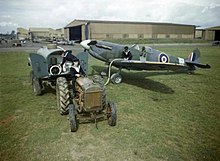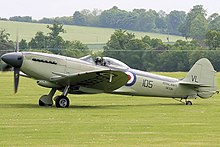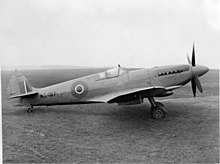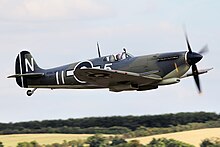Type a search term to find related articles by LIMS subject matter experts gathered from the most trusted and dynamic collaboration tools in the laboratory informatics industry.
| 761 Naval Air Squadron | |
|---|---|
| Active | 1 August 1941 - 16 January 1946[1] |
| Country | |
| Branch | |
| Type | Fleet Air Arm Second Line Squadron |
| Role | Naval Air Fighter School |
| Size | Squadron |
| Part of | Fleet Air Arm |
| Garrison/HQ | RNAS Yeovilton (HMS Heron) RNAS Henstridge (HMS Dipper) |
| Aircraft | See Aircraft operated section for full list. |
| Commanders | |
| Notable commanders | Lieutenant Commander Richard John Cork, DSO, DSC Commander Stanley Gordon Orr, DSC & Two Bars, AFC |
| Insignia | |
| Identification Markings | unknown (All types 1941 - 1942) G1A+ to G6A+ (All types 1943)[2] |

761 Naval Air Squadron (761 NAS) was a Naval Air Squadron of the Royal Navy's Fleet Air Arm. It was formed at HMS Heron, RNAS Yeovilton, as the Advanced Training Squadron of the Fleet Fighter School, in 1941. The squadron moved to HMS Dipper, RNAS Henstridge, in 1943, as part of the No. 2 Naval Air Fighter School. It remained at HMS Dipper and in this role, until January 1946, when the squadron disbanded.
761 Naval Air Squadron formed, on 1 August 1941, at RNAS Yeovilton (HMS Heron) near Yeovil, Somerset.[3] It was formed out of 760 Naval Air Squadron's Fairey Fulmar, a carrier-based reconnaissance/fighter aircraft and tasked as the Advanced Training Squadron of the Fleet Fighter School, and it used RNAS Haldon (HMS Heron II) for air firing practice.[4] During 1942, Blackburn Roc, a carrier-based turret fighter aircraft and Supermarine Spitfire I, a single-seat fighter aircraft, were received by the squadron.[2]

On 10 April 1943, 761 Naval Air Squadron relocated to RNAS Henstridge (HMS Dipper), situated near Henstridge, in Somerset, as part of No.2 Naval Air Fighter School. At this point, the squadron was equipped with a mix of eighteen Supermarine Spitfire and Supermarine Seafire, the latter a navalised Spitfire fighter aircraft, along with six Miles Master, an advanced trainer aircraft.[5]
Utilising 'D' Flight, trainees went about real deck landing training on the Attacker-class escort carrier, HMS Ravager, and the aircraft carrier, (converted from an ocean liner), HMS Argus.[2] Supermarine Seafire was the main aircraft operated by the squadron and by June 1944, sixty-eight Supermarine Seafire fighter aircraft were being used, consisting various marks.[4]
761 Naval Air Squadron disbanded at RNAS Henstridge (HMS Dipper) on 16 January 1946.[5]
The squadron has operated a number of different aircraft types, including:[3][2]


761 Naval Air Squadron operated from a couple of naval air stations of the Royal Navy, in England:[3][2]
List of commanding officers of 761 Naval Air Squadron with month and year of appointment:[3][2]